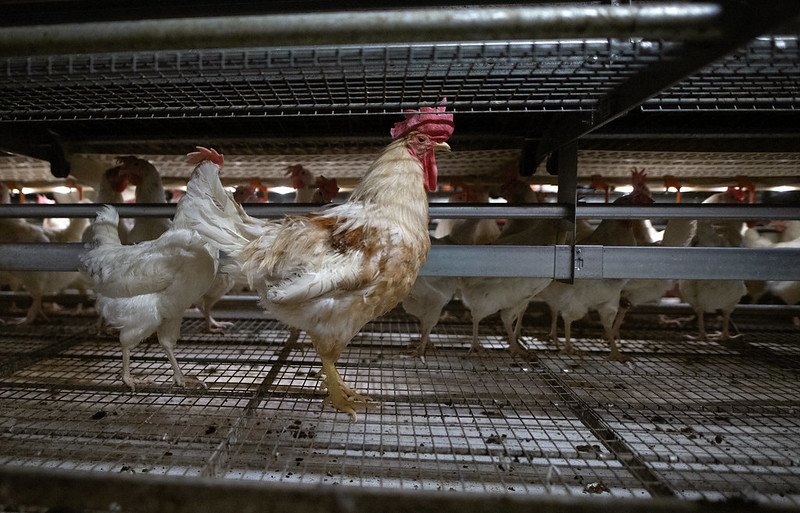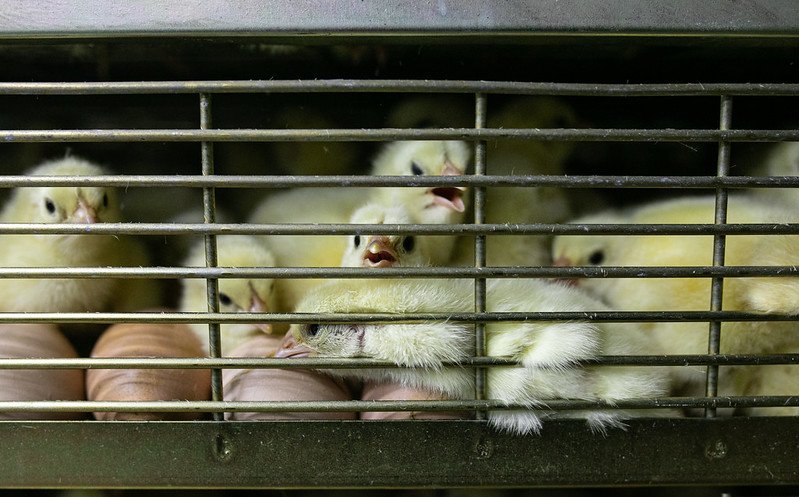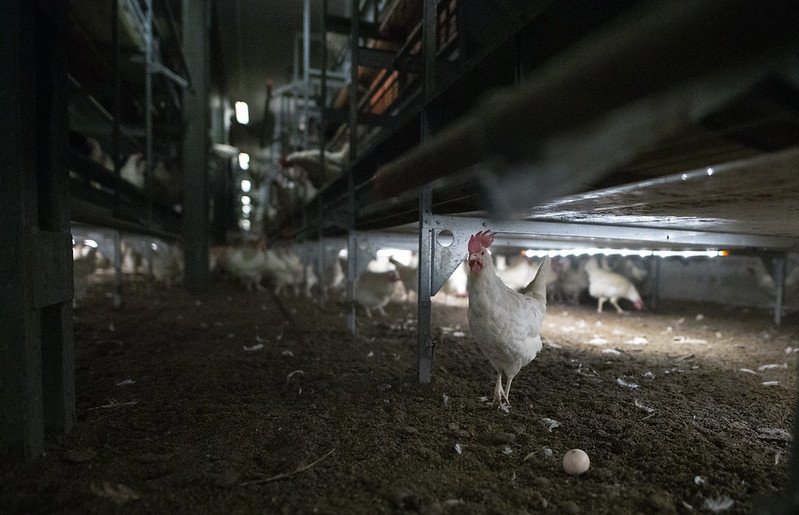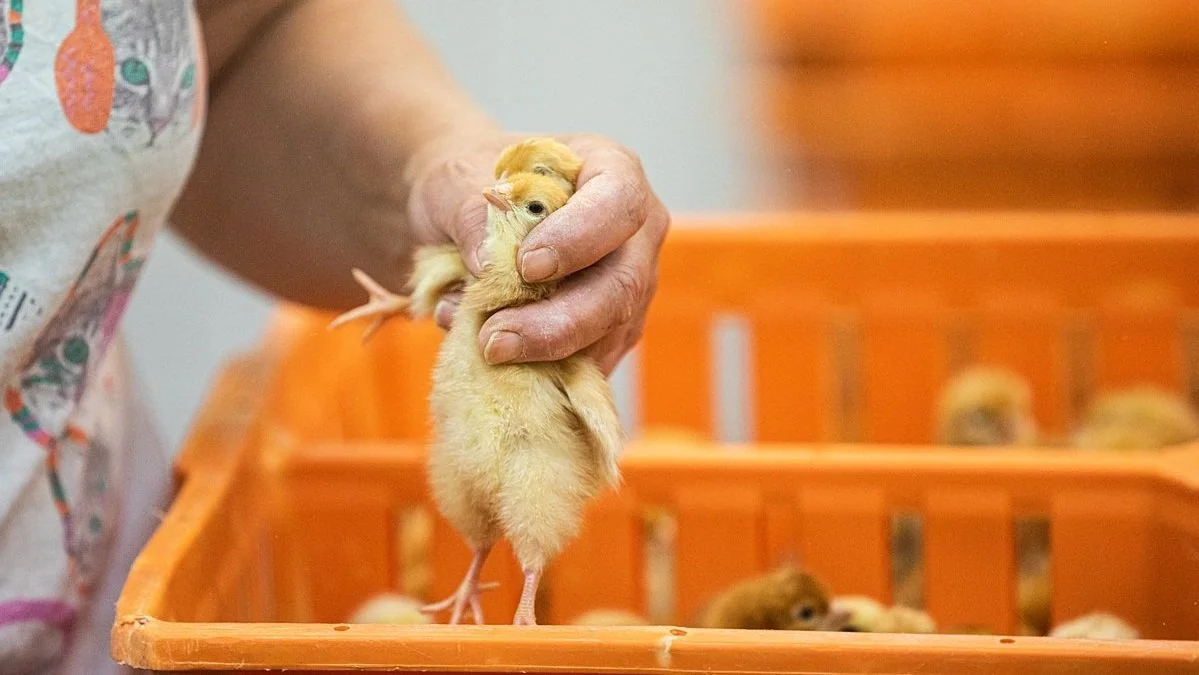The "No-Kill" Egg Illusion: What In-Ovo Sexing Really Means for Chickens
We could save billions of lives each year, but instead, society is focusing on how to kill them in a kinder way.
In our previous post on in-ovo sexing, we discussed these emerging technologies and their role within the egg production apparatus, demonstrating how they perpetuate rather than eliminate the suffering inherent to this industry.
Sentient's recent exposé on ‘Kipster’'s calculated entry into the US market, complete with their carefully marketed pledge to raise male chicks for meat, compels us to revisit this critical issue. What we're witnessing is nothing short of a co-optation of our movement's language and moral urgency. This post will expose what actually happens to male chicks under these new technologies and why every welfare reform ultimately fails to liberate animals from commodification.
From Exposing Cruelty to Comforting Labels: How the Industry Reframes the Debate
Few cruelties in the egg industry are as publicized as the mass culling of male chicks.
For years, activists have shared shocking footage of newborn chicks falling into grinders or suffocating in sacks, forcing the public to confront the hidden violence behind every carton of eggs.
Now, tech companies and egg producers are racing to market in-ovo sexing technologies that promise to “spare” male chicks by destroying them before they hatch.
While activists use the horror of chick culling to urge people to ditch eggs, these companies seize the moment to offer comforting labels and welfare promises, letting consumers believe their conscience can rest easy.
The egg industry is quick to adopt buzzwords: “no-kill eggs,” “cull-free,” “humane eggs.” Certification programs like ‘Hatch Check’ in the US reinforce these claims, but the reality is far less comforting.
This marketing works because most consumers don't know the details. While 82% of people say they'd prefer “no-kill” eggs, only 11% know male chick culling is standard practice. The industry relies on this gap, using emotional language to soothe consumer guilt while the fundamental ethical problems remain untouched.
Even ‘Kipster’, a company often cited for its commitment to raising male chicks, recently told Sentient that in-ovo sexing is only a temporary solution in the U.S., openly acknowledging that destroying male eggs is a shortcoming compared to their desired goal of raising males for food.
This shift isn't about ending cruelty. It's about moving it out of sight and selling the illusion of cruelty-free.
What Really Happens to Male Chicks: The “Kinder” Killing
In-ovo sexing determines the sex of chicken embryos inside fertilized eggs before hatching, allowing hatcheries to remove male embryos between days 4 and 13 of incubation. The technology uses various methods like optical scanning, genetic analysis, or experimental sound wave treatments. This timeline is significant, as scientific consensus suggests chicks begin to develop pain perception around day 13, which companies use to justify early destruction as more “humane.”
Here's what actually happens to those male embryos the industry claims to “spare”:
Crushed and processed as eggs: The overwhelming majority of male eggs identified by in-ovo sexing are destroyed before hatching and processed into animal feed, pet food, or protein powder.
‘Respeggt’ (Germany/Europe/US) uses the Seleggt Circuit to extract fluid from eggs on day 9, identifies male embryos, and removes them for processing into animal feed.
‘In Ovo’ (Netherlands) uses their “Ella” system to sample egg fluid on day 9, with male eggs also processed for feed.
‘CHEGGY’ (Germany/US) uses hyperspectral imaging for brown eggs, with male embryos removed and processed for animal feed.
‘Orbem’ (Germany) employs AI and MRI to identify sex by day 12; male eggs are processed before hatching.
Raised for meat (rare): Some companies, like ‘Kipster’ (Netherlands/US), have trialed raising male chicks for meat. However, this is rare and not scalable due to high costs, poor feed efficiency, and lack of market demand for rooster meat. Even ‘Kipster’ has now switched to in-ovo sexing in the US, citing infrastructure and economic barriers.
Turned into hens (experimental): ‘SOOS Technology’ (Israel/US) is piloting a method to convert genetic males into egg-laying hens using sound waves. This is still experimental and not commercially widespread.
No matter the method, the reality is clear: male chicks are not “spared.” They are simply eliminated earlier, out of sight, and often repurposed for economic gain. The industry's new language of “no-kill” and “humane” eggs is a marketing strategy, not a moral revolution.
Why Welfare Reforms Won't End Animal Suffering
In-ovo sexing exemplifies how welfare reforms serve industry interests rather than genuine animal protection. Despite the new marketing and technological advances, the ethical and economic realities remain unchanged.



Systematic destruction persists. Whether at day 1 or day 13, male lives are eliminated for economic efficiency. The timing changes, but the commodification of life continues unabated.
Female suffering persists. Hens on commercial egg farms endure painful debeaking, severe confinement, and slaughter when productivity declines. These females see no benefit from “no-kill” marketing. Their lives remain just as confined, just as painful, just as short.
Suffering of the parent flocks persists. These breeding birds, the unseen origin of every egg, live stressful and restricted lives. Hens and roosters bred specifically for fertile egg production endure chronic confinement, minimal freedom, and relentless reproductive demands. Their conditions remain unaffected by the shift to in-ovo sexing.
Companies adopt in-ovo sexing for profit, not compassion. It reduces costs, increases efficiency, and creates new revenue streams from processed male eggs. In-ovo sexing adds less than 1 cent per egg to production costs but offers significant savings in labor, feed, and space.
This pattern repeats across all animal industries: cage-free eggs, grass-fed beef, humane slaughter.
Each “improvement” allows consumers to continue participating in animal exploitation with reduced guilt, providing the illusion of progress while maintaining the profitable status quo.
The language changes, but the fundamental relationship remains the same: animals exist for human profit.
The Real Solution
But you have the power to step outside this system entirely. Every time you choose compassion over convenience, you're taking a stand. If you truly care about animal well-being, please look beyond the labels and marketing promises.
The real solution to ending the suffering of hens isn't a new technology or a comforting promise. It's refusing to participate in a system built on animal exploitation. It's recognizing that no matter how we dress it up, using animals for food means treating them as commodities rather than the individuals they are.
You don't need to wait for the industry to change. You can change right now, with your next meal, your next shopping trip, your next choice. The animals are counting on us to see through the illusion and choose a different path entirely.
Additional Information
-
What is in-ovo sexing?
In-ovo sexing is a technology that determines the sex of a chicken embryo inside a fertilized egg before hatching, allowing hatcheries to remove male embryos before they hatch into chicks.
What happens to the male embryos?
They are removed from incubation between days 4 and 13 and destroyed, then typically processed into animal feed or protein powder. Some companies have trialed raising these males for meat or converting them into egg-laying hens, but these approaches are rare or experimental.
Are “no-kill” or “cull-free” eggs cruelty-free?
No. These labels only mean no chicks are killed after hatching. Male embryos are still destroyed, just earlier. The ongoing suffering of hens and broader exploitation continue unchanged.
Is in-ovo sexing legally required?
Only a few countries (Germany, France, and soon Italy) have banned male chick culling by law, pushing producers toward in-ovo sexing. Elsewhere, adoption is voluntary or market-driven.
Is this practice common worldwide?
Europe leads globally, with over 28% adoption. North America is just beginning to adopt commercially, and most of the world still relies on traditional chick culling.
Does in-ovo sexing increase the price of eggs?
Slightly. The additional cost to consumers is minimal—typically less than 1 cent per egg—but producers see economic benefits through efficiency gains.
-
Liquid-Based Analysis Technologies
Respeggt (Seleggt Circuit) represents the most established commercial technology, operational since 2018. Using DNA analysis of allantoic fluid extracted on day 9 of incubation, male eggs are removed and processed into animal feed or protein powder. The technology now operates across multiple European countries and entered the US market in 2024 through partnerships with Kipster and other producers.
In Ovo’s Ella System employs a similar liquid sampling approach but uses proprietary biomarkers rather than DNA analysis. Operating since 2020, male eggs identified by this system are processed into animal feed. The technology processes 4,800 eggs per hour with over 98% accuracy.
PLANTegg utilizes PCR-based DNA analysis from allantoic fluid samples. Male eggs are processed into “high-quality feed” according to company specifications. The technology is owned by HatchTech Group and has been operational in Europe since 2020.
Imaging-Based Technologies
Orbem’s Genus Focus employs MRI and AI technology to detect sex differences in embryonic development on day 12 of incubation. Male eggs are processed into animal feed. The system can process up to 24,000 eggs per hour with modular design allowing scalability.
Agri Advanced Technologies’ CHEGGY uses hyperspectral imaging to identify sex based on feather color differences, working exclusively with brown layer breeds. Male eggs are processed into animal feed. The technology entered the US market in December 2024 through NestFresh, with eggs from in-ovo sexed hens reaching consumers in mid-2025.
MatrixSpec’s HyperEye represents the earliest sexing technology, capable of determination on day 4 of incubation. Currently in commercial validation in Canada, male eggs would be processed into animal feed. The system claims processing speeds of 30,000+ eggs per hour.
Emerging and Alternative Technologies
Sensit Ventures’ VOC Technology uses volatile organic compound detection to “sniff” sex-specific chemicals emitted through eggshells. Still in early-stage development, male eggs would be processed into animal feed if commercialized.
Omegga’s Spectroscopic Imaging develops non-invasive optical methods for sex detection, currently in pilot testing in Germany. Male eggs would be processed into animal feed.
SOOS Technology presents a unique approach using sound waves to convert genetically male embryos into phenotypically female chickens. Rather than destroying male embryos, this technology aims to create egg-laying birds from genetic males. Currently in limited commercial trials in the US and Israel.
-
Europe: The Pioneer Market
Europe leads global adoption with 20-28% market penetration as of 2024. Legal bans on male chick culling in Germany (2022), France (2023), and Italy (2026) have driven rapid adoption. Over 110 million of the EU’s 393 million laying hens were hatched using in-ovo sexing technology by April 2025.
The annual cost of in-ovo sexing in France alone ranges between €40-50 million, creating disputes between producers and retailers over cost-sharing. Despite these challenges, technological improvements have reduced costs from €4.00 per male bird in 2020 to €3.10 in 2024.
North America: Early Commercial Deployment
The United States saw its first commercial in-ovo sexed chicks in December 2024, with NestFresh becoming the first US producer to market such eggs. Kipster, the second US adopter, began using Respeggt technology in 2025, marking a significant shift from their previous commitment to raising male chicks.
The United Egg Producers launched the “Hatch Check” certification program in 2025, providing standards for in-ovo sexing verification. This represents industry-led adoption rather than regulatory mandates, with major retailers like Walmart including in-ovo sexing in supplier guidelines.
Canada is developing its own technology through the HyperEye system, with commercial validation underway and planned deployment in 2025.
Other Markets
Switzerland achieved industry-wide adoption through voluntary agreements, with both major hatcheries implementing in-ovo sexing for 100% of production by 2025. Norway reached 22% market penetration through voluntary adoption. Australia and the UK remain in early pilot stages, with limited commercial deployment.
Further Reading
How to Replace Eggs: Recipes and Resources
Ready to Go Vegan? Vegan Bootcamp




